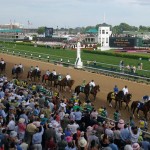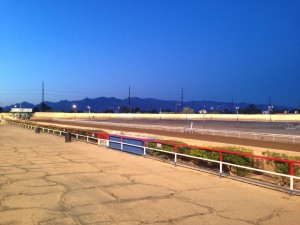It’s more than 1,500 miles from the dog track in Tucson to the horse track in Louisville where the Kentucky Derby glamour was on full display last weekend. And that is a world apart.
There are no silk suits and fancy ladies hats the size of manhole covers here. Instead, an old man wearing a grey sweatshirt and blue jeans sits alone on a rusting bench, one of fewer than 10 spectators on a night at a racetrack that used to attract thousands, but now attracts mostly bad publicity.

With his ticket in hand, the man rocks back and forth, hoping to strike gold as the famous “Call To The Post” trumpet flourish — the same as played by the splendidly uniformed bugler before a crowd of over 150,000 at Churchill Downs — echoes through the warm night at Tucson Greyhound Park. He sits and stares as Paul McCartney, Bob’s Gym and other uniquely named greyhounds sprint 600 yards on the track, in a little over 30 seconds.
After all eight greyhounds cross the finish line, the man gets up and returns to his perch at the bar to handicap the next race.
“I’ve been coming here since I was 18,” says another man standing to watch the dogs run. “This place has changed a lot over the years, it’s still the same sport but not the same place. This place used to be packed with people.” Neither spectator would provide names.
Currently the only standing greyhound racetrack in Arizona, the now 70-year-old Tucson Greyhound Park is hanging on by its paws, but looking to build off its once prosperous past. The owner is a company called ZapCon Inc., whose principals, Joseph Zappala and Robert Consolo Jr., couldn’t immediately be reached for comment.
A 1992 inductee to the Greyhound Hall of Fame, the park has seen six of the top 25 all-time leading greyhound race winners race on the track.
But last Monday, it was just Senator Susan versus Kb’s Darth Vader. And the only sound coming from the grandstands was a slight buzz — static put out by the aging track loudspeakers along with the patter by the track announcer. The empty benches were in sharp contrast to the big crowds that the track used to get under the lights.

That’s a far cry from what happened Saturday in Kentucky as that massive crowd packed Churchill Downs in suits, exotic hats and sundresses to watch what the media faithfully repeat is “The Fastest Two Minutes in Sports—The Kentucky Derby,” at the 140th running of the Derby.
“I’m a big-time gambling man,” the man watching the dogs race in Tucson boasts. “I’ll be here watching the Derby.” Tucson Greyhound Park is among the dozen or so dog tracks in the country that offered off-track-betting for the Kentucky Derby. The dog track is one of 10 locations in the city where off-track-betting businesses are authorized by the state.
Only half the building is lit. A smell that evokes of a cheap Las Vegas casino hits you the moment you step inside the door. The clubhouse décor resembles a bar at bowling alley. The tabletops are neon green, and most of the chairs on either side have damage of some kind from all the wear and tear.
A dimly lit lobby has a few men scattered throughout, mostly researching and watching one of the 30-plus television screens showing the race going on outside, as well as races from around the country. There’s a bar, but on this night, just one of the stools is occupied — by a man occasionally blurting out the lyrics to an old-school rap song as he sips a beer.
In the grandstand a total of seven people watch the first of 16 greyhound races. A security guard stands smoking a cigarette. Eight greyhounds held on a leash by young men and boys line up in front of the spectators. Some of the dogs are more anxious than others. They bark, yelp and pee before being put into the starting gates.
Suddenly, there’s a buzz in the air. But it’s not the buzz of excitement that customarily sweeps through a crowd before a race. It’s those loudspeakers again.
Dale Popp, a slender man, is a lot more polished than the rough exterior of the building he oversees. He is Tucson Greyhound Park’s general manager.
“These dogs are like professional athletes,” Popp asserts. “This is what they are born to do, and this is what they love to do.”
Brand new to the Southwest, Popp and his wife moved two months ago from Gainesville, Fla. to Tucson, on what he describes as a whim. A former retired manager at a Jai-Alai in Florida, Popp decided it was time to get back into the business.
“At some point you realize you’re too poor to retire,” Popp says.
So Popp reached out to his associates and quickly learned about a general manager position at the Tucson Greyhound Park. So he and his wife, who also worked at the Jai-Alai, packed up their things, said goodbye to their grandchildren, and headed west.
There was one condition.
“The plan was I come here and I get like a three month trial—sort of like a temporary position to see what I got myself into,” Popp said with a chuckle. “Boy did I get myself into something.”
Now two months into that three-month trial, Popp already has vision of what the park could be, but as of right now putting a timetable on that vision isn’t realistic.

For Popp, the first step is cleaning the park’s negative image. Just a month into his arrival, Popp had to deal with new bad publicity after a dog slipped underneath the guardrail during a race and was electrocuted by the electric wire that runs the lure — a kind of accident that Popp says is extremely rare and uncommon. Still, publicity over the accident, which was recorded on video, renewed calls for the dog track to be shut down.
Popp went on to say the safety and treatment of the dogs are his primary concern. He said that all the dogs are housed in kennels behind track in a modern building that has air conditioning and a computer that supposedly knows to keep the air conditioning running even if the power goes out. There is a yard for them to exercise, he pointed out.
That assessment of dog welfare does not comport with reports in the media about dog racing in the United States, or reports by anti-dog racing groups like Grey2K USA, which denounce dog racing as cruel to the greyhound dogs that are used. Dog racing, which peaked in the United States in the 1980s, is now in “catastrophic decline,” the organization says, and that assertion is not in dispute.
Even supporters concede that accidents do happen in dog racing — as they also do in horse racing, where the sight of a horse breaking down and being euthanized on the track is shocking, but it sometimes occurs. The media hype surrounding the Kentucky Derby aside, thoroughbred horse racing also has vociferous critics, including animal welfare groups, who argue that abuses lie behind racetrack glamour. And increasingly, the mainstream media underscoring those concerns.
Popp defends dog racing. “These dogs love to race so they’re going to get hurt, and that’s part of the nature of the sport,” he says.
Tough times have certainly hit the Tucson racetrack in recent years. About every sponsor has pulled out, making for tough financial going. And with only a handful of regulars visiting on a weekly basis, there isn’t exactly a new influx of cash from dog racing.
Popp knows he’s in for a long uphill battle. He has ideas, though, including a proposal for a 75-cent beer night for college students.
Seventy-five cents for a beer? At Derby weekend at Churchill Downs, a beer from a concession stand will run about $8. The famous Derby mint juleps — and the Derby says that 120,000 of the cocktails will be sold at Churchill Downs on Derby weekend — will cost $13. Do the math, as ESPN has.
Back in Tucson, hope springs eternal at the dog track. “This place can be a fun place and place for friends and family to come spend their weekend nights for a few hours,” Popp says. “But we really need to get the advertisements and have the community support before we can be thinking big picture.”
###


